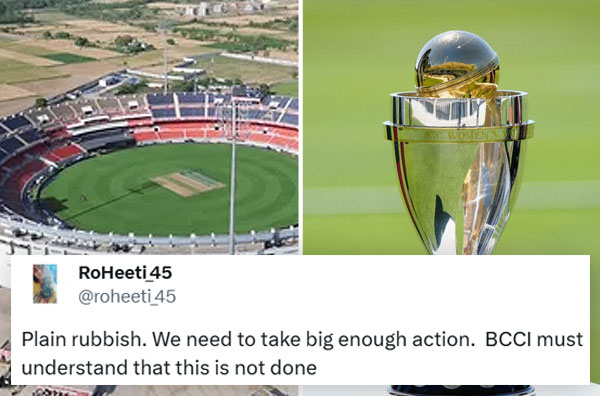In what feels like an afterthought rather than a celebration, the Board of Control for Cricket in India (BCCI) has quietly shortlisted Guwahati, Visakhapatnam, Mullanpur, Indore, and Thiruvananthapuram as venues for the ICC Women’s World Cup 2025. While India is set to host this global event for the first time in over a decade, the country’s cricketing body appears more invested in logistical balancing acts than elevating the women’s game.

The World Cup, set to begin in the last week of September, will be held in cities that are far removed from the major cricketing centers that recently packed stadiums during men’s ICC events and the Women’s Premier League. BCCI’s reasoning? Rotation policy.
As per a source within the board, smaller cities need their share now – not necessarily because they’re best suited to host women’s cricket, but because the bigger cities already had their turn.
“As the BCCI is going to host the 2026 World Cup, it was decided to give matches to all smaller cities so that they don’t get deprived of holding World Cup games. Those venues that will host Women’s World Cup games won’t be considered for the men’s T20 World Cup,” the source told The Indian Express.
There’s no real indication that this choice had anything to do with growing women’s cricket or capitalizing on the momentum built by the WPL. Instead, it seems the women’s game has simply been squeezed into the rotation schedule wherever convenient. Unsurprisingly, the decision has been met with criticism from fans and experts who feel this once-in-a-decade opportunity is being squandered.
The final of this landmark event will be played at Mullanpur’s Maharaja Yadavindra Singh International Stadium, a new venue that has never hosted a women’s international match. The stadium, now home to the Punjab Kings, may be state-of-the-art, but it stands in stark contrast to the historic venues that have hosted recent ICC women’s tournament finals: Lord’s (2017), MCG (2020), Hagley Oval (2022), Newlands (2023), and Dubai International Stadium (2024).
Inclusion of Thiruvananthapuram wasn’t exactly driven by fan base or infrastructure for women’s cricket either. It was chosen out of political necessity—the only shortlisted venue with immigration and visa clearance facilities. In case Pakistan qualifies (and refuses to play in India), matches involving them will take place in Sri Lanka or United Arab Emirates, and teams will fly from India’s southern coast.
A BCCI insider laid out this plan plainly:
“Since Pakistan won’t be travelling to India for ICC events, the BCCI will plan for all teams contesting against them to fly from the southern coast of India,” the source told The Indian Express.
The real energy around women’s cricket seems to be outside India right now. Pakistan will host the ICC Women’s Cricket Qualifiers from April 9, featuring Bangladesh, Ireland, West Indies, Thailand, and Scotland. Matches will be held at the Gaddafi Stadium and LCCA Ground in Lahore—venues familiar with high-stakes cricket. The top two teams from this qualifier will join India, Australia, England, South Africa, New Zealand, and Sri Lanka in the 2025 edition.
Of the five venues India has picked, only Visakhapatnam has hosted women’s internationals before—albeit not since 2014. Indore hosted Women’s World Cup matches two decades ago at the Nehru Stadium, but not at the newer Holkar venue. Guwahati, Mullanpur, and Thiruvananthapuram are essentially debutants in women’s cricket hosting duties.
Still, Visakhapatnam will get the opening ceremony and the first match, adding a symbolic shimmer to a plan that otherwise appears half-hearted.
While women’s cricket continues to grow globally, India’s approach remains cautious—borderline dismissive. Even as India hosted the Women’s ODI World Cup in 2013, it only involved Mumbai and Cuttack. In the 2016 T20 World Cup, cities like Delhi, Mumbai, Kolkata, and Chennai saw action. But now, those stadiums have been deemed too valuable—for the men’s game.
This shift is particularly baffling given recent crowd-pulling performances during WPL games and women’s bilateral matches in cities like Bengaluru, Mumbai, Delhi, and Lucknow. These venues successfully attracted fans and created buzz. So, if they weren’t going to be considered for the World Cup, what was the point of “testing” them with other women’s games?
The board’s priorities are further questioned as India enters this World Cup without legends Mithali Raj and Jhulan Goswami, both of whom retired since the last edition. With younger stars ready to take the mantle, this could have been a landmark moment to position women’s cricket at the forefront.
Instead, it feels like the BCCI has ticked off a checkbox. No grand announcement. No major promotional drive. Just a quiet reveal of venues, a rotation-based explanation, and a tournament buried beneath scheduling convenience.
Fans flocked to X (formerly Twitter) to express their disappointment, slamming the BCCI for sidelining major venues and treating the Women’s World Cup as an afterthought.

Loves all things female cricket